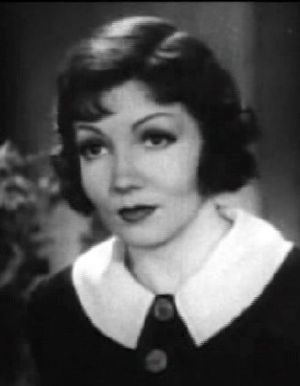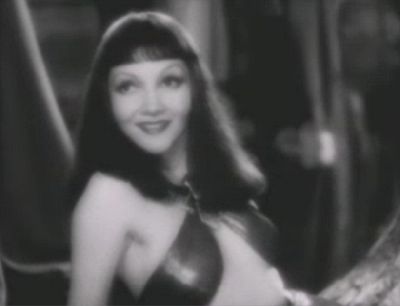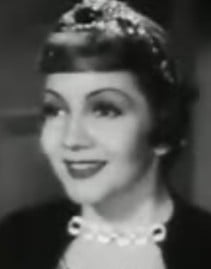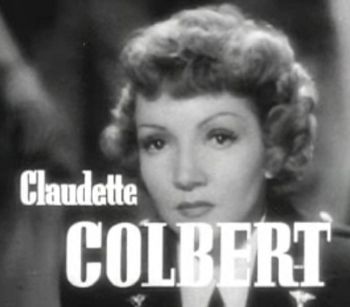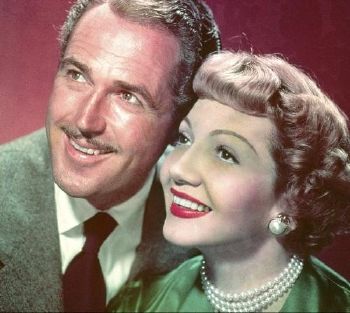Claudette Colbert
| Claudette Colbert | |
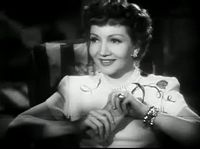 in The Secret Heart (1946) | |
| Birth name: | Émilie Claudette Chauchoin |
|---|---|
| Date of birth: | September 13 1903 |
| Date of death: | July 30 1996 (aged 92) |
| Death location: | Speightstown, Barbados |
| Academy Awards: | Academy Award for Best Actress 1935 It Happened One Night |
| Spouse: | Norman Foster (1928–1935) Dr. Joel Pressman (1935–1968) |
Claudette Colbert (IPA: /koʊlˈbɛɹ/) (September 13, 1903 – July 30, 1996) was a French-born American Academy Award-winning actress of film and theater whose versatility encompassed every genre from screwball comedies to historical drama. Throughout her career she resisted typecasting and was nominated for and won an Academy Award for her role as the plucky runaway heiress in It Happened One Night (1934) and nominated for her dramatic role in Since You Went Away (1944).
At a time when American women were entering the workforce after World War II, Colbert embodied the ideal of the independent, resourceful, and comedic female living through all manner of obstacles and doing so with style and confidence. Throughout her career, which spanned 60 years, she made the transition from stage and silent film to "talkies" and later to television. Regarded not only for her expert comedic timing, she was also well known for her business acumen as an astute manager of her career during Hollywood's Golden Age.
A recipient of France's Legion of Honor, she also received the Lifetime Achievement Award at the Kennedy Center in 1989.
Early life
Émilie Chauchoin[1] was born in Saint-Mandé, Seine, France,[2] to Georges Claude, a banker, and Jeanne Loew Chauchoin.[3] Her family emigrated to New York City in 1906.[4] Colbert eventually became a naturalized citizen of the U.S.
Colbert studied at Washington Irving High School, where her speech teacher, Alice Rossetter helped her overcome a slight lisp. Rossetter encouraged her to audition for a play she had written, and Colbert made her stage debut at the Provincetown Playhouse in The Widow's Veil, at the age of 15.
She then attended the Art Students League of New York. She originally aspired to become a fashion designer, but after landing a small role on the Broadway Stage in The Wild Westcotts (1923) she was motivated to pursue a career in theater. She adopted the name "Claudette Colbert" as her stage name two years later. She had been using the name of Claudette since high school; Colbert was the maiden name of her maternal grandmother.[5]
Career
Broadway
Colbert played ingenue roles on Broadway from 1925 through 1929. During her early years on stage, she fought against being typecast as a maid. She received critical acclaim on Broadway in the production of The Barker (1927) playing a carnival snake charmer, a role she reprised for the play's run in London's West End.[6]
See Naples and Die and Eugene O'Neill's Dynamo (1929) were unsuccessful plays, however she was noticed by the theatrical producer, Leland Hayward, who suggested her for a role in Frank Capra's silent film For the Love of Mike (1927), now believed to be a lost film.[7] The film, Colbert's only silent film role, was a box office failure.
Early film career
After the failure of For the Love of Mike, Colbert did not make any films for two years, but eventually signed a contract with Paramount Pictures in 1929. Her first "talkie" was The Hole in the Wall (1929), co-starring another newcomer, Edward G. Robinson, which was followed by The Lady Lies (1929).
She appeared in the French language, Mysterious Mr. Parkes, one of the few foreign language films of the time to be widely screened in the United States, and was also cast in The Big Pond. The latter was filmed in both French and English, and Colbert's fluency in both languages was a key consideration in her casting.[8]
She co-starred with Fredric March in Manslaughter (1930), and received positive reviews for her performance as a rich girl, jailed for manslaughter. She made four films together with March, including Honor Among Lovers (1931). She sang in her role opposite Maurice Chevalier in the Ernst Lubitsch musical The Smiling Lieutenant (1931), which was nominated for an Academy Award for Best Picture.
Cecil B. DeMille cast her as the Roman empress Poppaea in his historical epic, The Sign of the Cross (1932). In one sequence, Colbert bathes in a marble pool filled with milk, a scene that came to be regarded as an example of Hollywood decadence prior to the enforcement of the Production Code.[9] Later the same year she played in The Phantom President, which was one of Paramount's biggest failures of the year. Other successes of this period included Tonight Is Ours (1933) with Fredric March and Torch Singer (1933), with Ricardo Cortez.
It Happened One Night
During 1934, Colbert's film career flourished. Of the four films she made that year, three of them; the historical biography, Cleopatra, the romantic drama, Imitation of Life and the screwball comedy, It Happened One Night were nominated for Academy Awards for Best Picture.
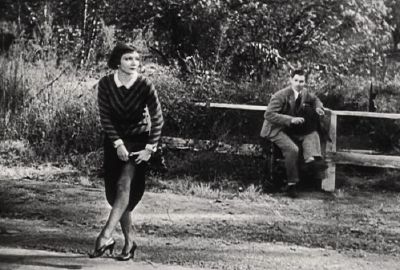
Colbert was reluctant to appear as the "runaway heiress," Ellie Andrews, in the Frank Capra romantic comedy, It Happened One Night (1934), opposite Clark Gable and released by Columbia Pictures. Behind schedule after several actresses had refused the role, the studio accepted Colbert's demand that she be paid $50,000 and that filming was to be completed within four weeks to allow her to take a planned vacation. Colbert felt that the script was weak, and Capra recalled her dissatisfaction, commenting, "Claudette fretted, pouted and argued about her part... she was a tartar, but a cute one."[10]
The film contained at least one scene that is often cited as representative of the screwball film genre[11][12] Stranded in the countryside, Colbert demonstrates to an astonished Gable how to hitchhike by displaying her leg. Colbert won the Academy Award for Best Actress for her role. The film was the first to sweep all five major Academy Awards, including Best Picture, Best Director and Best Actor.
In 1935 she received a second Academy Award nomination for her role in the hospital drama, Private Worlds.
In 1936, she signed a new contract with Paramount Pictures, which required her to make seven films over a two year period; this contract made her Hollywood's highest paid actress.[13]
Colbert was able to assert control over the manner in which she was portrayed and she gained a reputation for being fastidious by refusing to be filmed from her right side. She believed that her face was uneven and photographed better from the left. She learned about lighting and cinematography, and refused to begin filming until she was satisfied that she would be shown to her best advantage.
Drums Along the Mohawk (1939) with Henry Fonda was Colbert's first color film, however she distrusted the relatively new Technicolor process and feared that she would not photograph well, preferring thereafter to be filmed in black-and-white.[14]
Later film career
In 1940, Colbert refused a seven-year contract that would have paid her $200,000 a year, as she had found that she could command a fee of $150,000 per film as a free-lance artist. With her brother as her manager, Colbert was able to secure roles in prestigious films, and this period marked the height of her earning ability.[13]
Colbert's film career continued successfully into the 1940s, in films such as Boom Town (1940), with Clark Gable, Spencer Tracy and Hedy Lamarr, and Arise, My Love (1940), with Ray Milland.
After more than a decade as a leading actress, Colbert began to make a transition to more mature characters. Aware of Colbert's sensitivity about her age, David O. Selznick approached her to play the lead role in Since You Went Away (1944). She balked at the prospect of playing a mother of teenaged children, but Selznick believed that she was the best candidate for the role, and valued her marketability, commenting that "even light little comedies with her have never done under a million and a half."[15]
Released in June 1944, the film became a substantial success and grossed almost five million dollars in the United States. Colbert received her final Academy Award nomination for this performance.
In 1945, Colbert ended her association with Paramount Studios, and continued to free-lance in such films as Guest Wife (1945), with Don Ameche. RKO Studios hired her to appear opposite John Wayne in Without Reservations (1946), with a storyline and setting intentionally inspired by It Happened One Night, however it failed to recoup its high production costs.[16] Nonetheless, the overall popularity of Colbert's films during 1946 led to her making a final appearance in her last great success playing opposite Fred MacMurray in the comedy The Egg and I (1947). The film was one of the year's biggest hits, and was later acknowledged as the 12th most profitable American film of the 1940s.[14]
Colbert's one regret was her inability to play the part of Margo Channing in All About Eve, a role written with her in mind by Joseph Mankiewicz who admired her "sly wit and sense of class."[17] Colbert was enthusiastic about the project, and after a succession of patrician roles, relished the prospect of playing what she described as a more "feline" character. However, before production started, Colbert severely injured her back, while filming a scene for Three Came Home, and although 20th Century Fox postponed the production of All About Eve for two months while she convalesced, she was still not fit enough to take the role and was replaced by Bette Davis.
Television and theater
In the early 1950s, Colbert traveled to Europe and began making fewer films. In 1954, after a successful appearance in a television version of The Royal Family, she began acting in various teleplays. From 1954 to 1960, she appeared in the television adaptations of Blithe Spirit in 1956 and The Bells of St. Mary's in 1959. She also guest starred on Robert Montgomery Presents, Playhouse 90, and Zane Grey Theater.
In 1958, she returned to Broadway in The Marriage-Go-Round, for which she was nominated for a Best Actress Tony Award.
By 1955 she had stopped making films, although she returned to the screen in Parrish (1961) for Warner Brothers with newcomer Troy Donahue. The film was not a success and Colbert instructed her agent to stop his attempts to generate interest in her as a film actress. In the late 1960s, a reporter asked her why she had made no more films, to which she replied, "Because there have been no offers."[13]
Her occasional acting ventures were limited to theater and included The Irregular Verb to Love (1963); The Kingfisher (1978) in which she co-starred with Rex Harrison, and Frederick Lonsdale's Aren't We All? (1985).
In 1987, Colbert appeared in a supporting role in the television miniseries The Two Mrs. Grenvilles. The production was a ratings success and was nominated for several awards. Colbert won a Golden Globe and received a nomination for an Emmy Award. This marked her final performance on film, but she continued to act in theater.
Personal life
In 1928, Colbert married Norman Foster, an actor and director, who appeared with Colbert in the Broadway show The Barker. However, she and Foster lived apart, never sharing a home together in Hollywood.[18] They divorced in 1935, and in December of that year, Colbert married Dr. Joel Pressman, a surgeon at UCLA.[5] The marriage lasted 33 years, until Pressman's death of liver cancer in 1968.
Colbert had one brother, Charles (1898-1971), who served as her agent and business manager during the height of her career.[3]
Colbert was a staunch Republican and conservative.[19]
Final years
For years, Colbert divided her time between her apartment in Manhattan and her summer home in Speightstown, Barbados. After suffering a series of strokes in 1993, she remained in her Barbados home, Belle-rive, where she died on July 30, 1996, at age 92.[5] She was buried in the Parish of St. Peter Cemetery in Barbados.[20] Colbert left no immediate family.[5]
The bulk of Colbert's estate was left to a friend, Helen O'Hagan, a retired director of corporate relations at Saks Fifth Avenue, whom Colbert had met in 1961 on the set of the her last film and who cared for Colbert following her 1993 strokes.[21]
Legacy
Colbert established one of the most successful film careers of any actress of her generation. She was said to have been proud of the fact that she never had formal training as an actress, and had what she called 'an instinct for the craft.'
In discussing Colbert's career, her contemporaries confirmed her drive. Irene Dunne commented that she had lacked Colbert's "terrifying ambition" and noted that if Colbert "finished work on a film on a Saturday, she would be looking for a new project by Monday." Hedda Hopper wrote that Colbert placed her career "ahead of everything save possibly her marriage," and described her as the "smartest and canniest" of Hollywood actresses.
Colbert was also generally respected for her professionalism, with the New York Times stating that she was known for giving "110 percent" to any project she worked on, and she was also highly regarded for learning the technical aspects of studio lighting and cinematography that allowed her to maintain a distinctive film image.[13] In her biography, Myrna Loy stated that Colbert, along with Joan Crawford, "knew more about lighting than the experts did."[22]
Modern critics and film historians note that Colbert demonstrated versatility throughout her career, and played characters that ranged from vamps to housewives, and that encompassed screwball comedy and drama.[13] Pauline Kael wrote that Colbert was widely admired by American audiences from the time of It Happened One Night because she represented "Americans' idealized view of themselves—breezy, likable, sexy, gallant and maybe just a little hare-brained."[11] Of her distinctive, yet individual style and her ability to resist being typecast Colbert once said, "I don't need that awful artificial glamor that Hollywood devises for people who don't have any personalities."[6]
She was praised for her sense of style and awareness of fashion, and she ensured throughout her career that she was impeccably groomed and costumed. When she received a Kennedy Center Honor, her fashion sense was referred to with a quotation from Jeanie Basinger in The International Dictionary of Films and Filmmakers: "[Her] glamor is the sort that women attain for themselves by using their intelligence to create a timeless personal style."[23] The writer A. Scott Berg described Colbert as one of Paramount Studio's greatest assets as she had "proved deft in all genres" and had "helped define femininity for her generation with her chic manner."[24]
Colbert is cited as a leading female exponent of screwball comedy, along with such actresses as Carole Lombard, Myrna Loy, Rosalind Russell, Irene Dunne and Jean Arthur. In her comedy films, she invariably played shrewd and self reliant women, but unlike many of her contemporaries, Colbert rarely engaged in physical comedy, with her characters more likely to be observers and commentators.[25]
Filmography
- The Gilded Lily (1935)
- The Bride Comes Home (1935)
- She Married Her Boss (1935)
- Under Two Flags (1936)
- Maid of Salem (1937)
- Tovarich (1937)
- Bluebeard's Eighth Wife (1938)
- Zaza (1939)
- Midnight(1939)
- It's a Wonderful World (1939)
Awards
Colbert was nominated for the Academy Award for Best Actress for three films, It Happened One Night (1935), Private Worlds (1936), and Since You Went Away (1945), winning for It Happened One Night. In addition, she won a Golden Globe Award for Best Supporting Actress in a Series, Mini-series, or Motion Picture Made for Television for her role in The Two Mrs. Grenvilles (1988), and was nominated for an Emmy Award for the same.
In 1980, Colbert was awarded the Sarah Siddons Award for her theater work.[26] In 1984, Colbert was awarded the Gala Tribute award by the Film Society of Lincoln Center.[27] The same year, a building at the old Kaufman Astoria Studios in New York, where she had made ten films early in her career, was renamed in her honor.[28] In 1985, Colbert was awarded the Special Awards by Drama Desk Award.
In 1989, Colbert was the recipient of the Kennedy Center Honors for lifetime achievement.[23] In 1990, Colbert was honored with the San Sebastián International Film Festival Donostia Lifetime Achievement Award.[29]
In 1999, the American Film Institute placed Colbert at number 12 on their "AFI's 100 Years… 100 Stars" list of the "50 Greatest American Screen Legends".[30] For her contribution to the motion picture industry, Claudette Colbert has a star on the Hollywood Walk of Fame at 6812 Hollywood Blvd.
| Awards | ||
|---|---|---|
| Preceded by: Jessica Tandy |
Sarah Siddons Award 1980 |
Succeeded by: Angela Lansbury |
| Preceded by: Olivia de Havilland for Anastasia: The Mystery of Anna |
Golden Globe Award for Best Supporting Actress in a Series, Mini-series, or Motion Picture Made for Television 1988 for The Two Mrs. Grenvilles |
Succeeded by: Katherine Helmond for Who's the Boss |
Notes
- ↑ Claudette Colbert Cineartistes.com (in French) Retrieved July 5, 2022.
- ↑ Claudette Colbert British Film Institute. Retrieved July 5, 2022.
- ↑ 3.0 3.1 Lawrence J. Quirk, Claudette Colbert An Illustrated Biography (Crown Publishers, 1974, ISBN 0517556782), 5.
- ↑ Ellis Island National Monument: Destined For Fame Oh Ranger. Retrieved July 5, 2022.
- ↑ 5.0 5.1 5.2 5.3 Eric Pace, Claudette Colbert, Unflappable Heroine of Screwball Comedies, is Dead at 92 The New York Times, July 31, 1996. Retrieved July 5, 2022.
- ↑ 6.0 6.1 Jeanine Basinger and Audrey E. Kupferberg.Claudette Colbert - Actors and Actresses Film Reference. Retrieved July 5, 2022.
- ↑ For the Love of Mike (1927) IMDb. Retrieved July 5, 2022.
- ↑ David Shipman, Movie Talk (St. Martin's Press, 1988, ISBN 978-0312034030), 113.
- ↑ Anne Edwards, The DeMilles, An American Family (William Collins, Sons & Co., 1988, ISBN 000215241X).
- ↑ Joel Hirschnor, Rating the Movie Stars for Home Video, TV and Cable (Publications International Limited, 1983, ISBN 0881761524, 87.
- ↑ 11.0 11.1 Pauline Kael, 5001 Nights at the Movies (Zenith Books, 1984, ISBN 0099335506), 285.
- ↑ I. G. Edmonds and Reiko Mimura, The Oscar Directors (Tantivy Press, 1980, ISBN 049802444X), 48.
- ↑ 13.0 13.1 13.2 13.3 13.4 David Shipman, The Great Movie Stars: The Golden Years (Hill & Wang Pub., 1987, ISBN 978-0809051700).
- ↑ 14.0 14.1 Joel W. Finler, The Hollywood Story (Wallflower Press, 2003, ISBN 978-1903364666).
- ↑ Ronald Haver, David O. Selznick's Hollywood (Knopf, 1980, ISBN 978-0394425955).
- ↑ Richard B. Jewell and Vernon Harbin, The RKO Story (Octopus Books, 1982, ISBN 0706412850), 211.
- ↑ Charlotte Chandler, The Girl Who Walked Home Alone, Bette Davis, A Personal Biography (New York: Simon & Schuster, 2006, ISBN 0743262085), 184.
- ↑ Claudette Colbert Turner Classic Movies. Retrieved July 5, 2022.
- ↑ Derek Granger, Obituary: Claudette Colbert The Independent, August 2, 1996. Retrieved July 5, 2022.
- ↑ Claudette Colbert Find A Grave. Retrieved July 5, 2022.
- ↑ Penelope Green, Helen O’Hagan, Fashion Executive Who Personified Saks, Dies at 89 the New York Times, July 9, 2020. Retrieved July 5, 2022.
- ↑ James Kotsilibas-Davis and Myrna Loy, Myrna Loy: Being and Becoming ( New York: Donald I. Fine Inc., 1988, ISBN 978-1556111013), 119.
- ↑ 23.0 23.1 Claudette Colbert The Kennedy Center. Retrieved July 5, 2022.
- ↑ A. Scott Berg, Goldwyn (Sphere Books, 1989, ISBN 074740593X), 190.
- ↑ Maria DiBattista, Fast Talking Dames (Yale University Press, 2001, ISBN 0300099037), 210.
- ↑ Awardees Sarah Siddons Society. Retrieved July 5, 2022.
- ↑ Nan Robertson, Film Society Honors Miss Colbert The New York Times, April 24, 1984. Retrieved July 5, 2022.
- ↑ Claudette Colbert at dedication of the "Claudette Colbert Building," Kaufman-Astoria Studios, New York, 1984 Library of Congress. Retrieved July 5, 2022.
- ↑ Claudette Colbert San Sebastián International Film Festival. Retrieved July 5, 2022.
- ↑ AFI's 100 Years, 100 Stars, American's Greatest Legends American Film Institute. Retrieved July 5, 2022.
ReferencesISBN links support NWE through referral fees
- Anderson, Christopher. An Affair to Remember, The Remarkable Love Story of Katharine Hepburn and Spencer Tracy. William Morrow and Co. Inc., 1997. ISBN 0688153119
- Berg, A. Scott. Goldwyn. Sphere Books, 1989. ISBN 074740593X
- Chandler, Charlotte. The Girl Who Walked Home Alone, Bette Davis, A Personal Biography. Simon & Schuster, 2006. ISBN 0743262085
- Chaneles, Sol, and Albert Wolsky. The Movie Makers. Secaucus, NJ: Derbibooks, 1974. ISBN 0890090025
- DiBattista, Maria. Fast Talking Dames. Yale University Press, 2001. ISBN 0300099037
- Edmonds, I. G. and Mimura, Reiko. The Oscar Directors. Tantivy Press, 1980. ISBN 049802444X
- Edwards, Anne. The DeMilles, An American Family. William Collins, Sons & Co., 1988. ISBN 000215241X
- Finler, Joel W. The Hollywood Story. Wallflower Press, 2003. ISBN 978-1903364666
- Harris, Warren G. Clark Gable, A Biography. Aurum Press, 2002. ISBN 1854109049
- Haver, Ronald. David O. Selznick's Hollywood. Knopf, 1980. ISBN 978-0394425955
- Hirschnor, Joel. Rating the Movie Stars for Home Video, TV and Cable. Publications International Limited, 1983. ISBN 0881761524
- Jewell, Richard B.n and Vernon Harbin. The RKO Story. Octopus Books, 1982. ISBN 0706412850
- Kael, Pauline. 5001 Nights at the Movies. Zenith Books, 1984. ISBN 0099335506
- Karney, Robyn. The Movie Stars Story, An Illustrated Guide to 500 of the World's Most Famous Stars of the Cinema. Octopus Books, 1984. ISBN 0706420926
- Kotsilibas-Davis, James, and Myrna Loy. Myrna Loy: Being and Becoming. New York: Donald I. Fine Inc., 1988. ISBN 978-1556111013
- Niven, David. Bring on the Empty Horses. Hodder Paperbacks, 2006. ISBN 978-0340839959
- Quirk, Lawrence J. Claudette Colbert An Illustrated Biography. Crown Publishers, 1974. ISBN 0517556782
- Shipman, David. The Great Movie Stars: The Golden Years. Hill & Wang Pub., 1987. ISBN 978-0809051700
- Shipman, David. Movie Talk. St. Martin's Press, 1988. ISBN 978-0312034030
- Springer, John. They Had Faces Then, Annabella to Zorina, the Superstars, Stars and Starlets of the 1930s. Citadel Press, 1978. ISBN 0806506571
External links
All links retrieved December 19, 2023.
- Claudette Colbert IMDb
- Claudette Colbert Reel Classics
- Claudette Colbert Find A Grave
| |||||
Credits
New World Encyclopedia writers and editors rewrote and completed the Wikipedia article in accordance with New World Encyclopedia standards. This article abides by terms of the Creative Commons CC-by-sa 3.0 License (CC-by-sa), which may be used and disseminated with proper attribution. Credit is due under the terms of this license that can reference both the New World Encyclopedia contributors and the selfless volunteer contributors of the Wikimedia Foundation. To cite this article click here for a list of acceptable citing formats.The history of earlier contributions by wikipedians is accessible to researchers here:
The history of this article since it was imported to New World Encyclopedia:
Note: Some restrictions may apply to use of individual images which are separately licensed.
